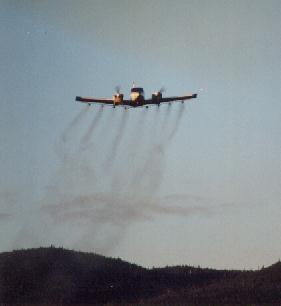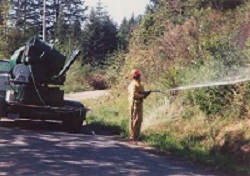Spraying with Btk
The most common treatment used to eradicate spongy moths (formerly referred to as gypsy moth) in B.C. is to spray with the biological insecticide Btk. Btk is a bacterium harmful only to moth and butterfly caterpillars. It must be applied by spraying.
On this page
Spraying from the air
Also known as aerial spraying, applying Btk from the air is the most efficient way to eradicate and suppress widespread spongy moth populations. This method has several important advantages over others.
Low Risk: Btk products pose a low risk to humans and other non-target organisms (other than moth and butterfly caterpillars). It can be applied over populated areas and water bodies with very little risk.
Effective: After several decades of use, aerial sprays have been proved to be highly effective for controlling the spongy moth.
Fast: Large areas can be treated in just a few hours. Most droplets will have reached the ground within 10 minutes of application.
Thorough: Aerial spraying can treat remote or difficult-to-access areas, providing even coverage throughout the target area. Also, and most important, the droplets can penetrate the crowns of even the tallest trees.
Cost effective: Aerial application has the lowest cost-per-hectare of any effective treatment.
Drawback: Aerial spraying has one technical disadvantage — weather limitations. Rain and wind are the most important limitations to aerial application of Btk. Spraying can be done in moderate winds but low-to-no-wind is preferred (treatments are not completed if wind speeds exceed 8 km per hour). A period of two hours without precipitation after spraying is required to allow Btk to stick properly to foliage.
General information about the aerial Btk spraying process
Date: Aerial spraying is usually carried out between April 1 and June 30. Exact dates depend both on spongy moth development and the weather.
Time: Spraying starts between dawn and is typically completed before 7:30 a.m. in populated areas.
Duration: Spraying usually takes about two hours per application and depends on the treatment area.
Number of applications: There are usually three applications of Btk, ideally spaced 7 - 10 days apart. The actual time between sprays will depend on insect development and weather.
Public awareness:
- A public notice is released at least 24 hours in advance of any aerial application, through media releases, updates on the spongy moth news web page, automated emails are sent to the spongy news web page subscribers, and updates to the toll-free, 24-hour information line.
- All schools and hospitals in the affected areas are notified in writing at least 24 hours before a spray is conducted
Safety: Highly trained spray specialists use a multi-engine aircraft, with all activities monitored by the project team. All necessary safety precautions are taken to ensure minimal risk to the public and the applicators.
Impact on the public: Aircraft flying as low as 150 feet above ground level apply the Btk. The public will hear aircraft noise during the early morning.
Spraying from the ground
Btk can be sprayed also from the ground. Hydraulic sprayers are the most efficient of the available ground-level methods for applying Btk.
A hydraulic sprayer distributes the insecticide in a stream of liquid onto the foliage of trees and shrubs, usually until run-off is visible. Hydraulic sprayers have limited reach but can be quite effective at delivering Btk into the crowns of trees. Ground spraying is a viable treatment option for eradication of spongy moth when populations are small and isolated in known areas. In addition, ground spraying can specifically target potential host vegetation without treating other objects like houses, fences and non-host trees and shrubs.
Under the recently enacted Integrated Pest Management Act, ground spraying of Btk formulations does not require a Pesticide Use Permit.
Ground spraying is less effective when tree crowns are very high or dense. Other disadvantages of ground spraying:
- Ground spraying is as effective as aerial spraying only when host vegetation is fully accessible
- Ground spraying is labour intensive, so is more expensive for larger areas
- Both residents near the spraying area and the person applying the spray are more exposed to the insecticide than with aerial spraying, though Btk formulations do pose minimal health risks
- Ground spraying is often intrusive, as it requires entry onto private land, and trucks and sprayers are set up in the streets for several days
- Ground spraying must be conducted throughout the day during daylight hours when the public is out and about, whereas aerial spraying is conducted rapidly (less than two hours) in the early morning
- Ground spraying is very slow. It takes several weeks to cover a fraction of the area treated from the air
- Though ground spraying is focused specifically on host vegetation, high localized drift can occur during daylight hours as the wind fluctuates
Aerial spraying

Ground spraying

Contact information
Contact us if you have further questions about spongy moths or how the species is controlled in B.C.
